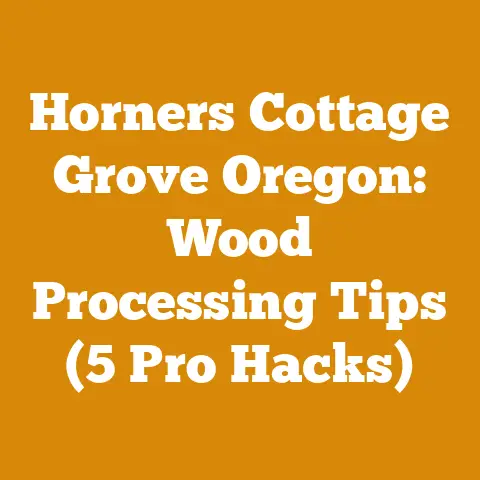Staining Board and Batten: Best Wood Finishes (5 Pro Secrets)
Let’s debunk a common myth right off the bat: that staining board and batten siding is just slapping on some color.
It’s far more than that!
It’s an art and a science, a dance between wood, stain, and weather.
Get it wrong, and you’ll be redoing it sooner than you think.
I’ve seen countless projects fail because of this misconception.
In this article, I’ll share my “5 Pro Secrets” to achieving a stunning and long-lasting finish on your board and batten siding.
Staining Board and Batten: Best Wood Finishes (5 Pro Secrets)
Board and batten siding offers a timeless aesthetic, whether it’s gracing a modern farmhouse or a rustic cabin.
But its beauty hinges on a proper finish.
Choosing the right stain and applying it correctly is crucial for both aesthetics and longevity.
This isn’t just about making your house look good; it’s about protecting your investment from the elements.
I’ve spent years working with wood, from felling trees to crafting fine furniture, and I can tell you that the finish is often the most critical step.
Why Staining Matters: Beyond Aesthetics
Before we dive into the “secrets,” let’s understand why staining is so important.
Unlike paint, which forms a surface layer, stain penetrates the wood, highlighting its natural grain and texture.
This is especially important for board and batten, where the interplay of light and shadow on the vertical boards creates visual interest.
- Protection: Stain contains pigments and resins that shield the wood from UV rays, moisture, and fungal growth.
Without proper protection, your siding can fade, warp, rot, and become a breeding ground for mold. - Durability: A good stain can significantly extend the life of your siding.
I’ve seen properly stained board and batten last for decades, while poorly finished siding deteriorates within a few years. - Aesthetics: Stain enhances the natural beauty of the wood, allowing the grain to shine through.
You can choose from a wide range of colors and opacities to achieve your desired look.
Key Terms: Understanding the Language of Wood
To make sure we’re on the same page, let’s define some key terms:
- Board and Batten: A type of siding consisting of wide vertical boards joined by narrow strips of wood called battens.
- Stain: A penetrating finish that colors the wood while allowing the grain to show through.
- Sealer: A clear coating applied before stain to control absorption and ensure even color.
- Topcoat: A protective layer applied after stain to enhance durability and resistance to the elements.
- VOC (Volatile Organic Compounds): Chemicals released by some stains and finishes that can be harmful to human health and the environment.
Look for low-VOC options. - Green Wood vs.
Seasoned Wood: Green wood is freshly cut and has a high moisture content.
Seasoned wood has been dried to a lower moisture content, making it more stable and receptive to finishes.
Now, let’s get to those pro secrets.
Pro Secret #1: Wood Selection and Preparation is Paramount
This is where many projects go wrong.
You can’t just slap stain on any old wood and expect a great result.
The type of wood you choose and how you prepare it will significantly impact the final finish.
Choosing the Right Wood
- Durability: Consider the climate in your area.
For harsh weather, opt for naturally durable woods like cedar, redwood, or cypress.
These species contain oils and extractives that resist rot and insect damage. - Grain Pattern: Different woods have different grain patterns.
Cedar and redwood have a beautiful, straight grain, while pine can have more knots and character.
Choose a grain pattern that complements your desired aesthetic. - Cost: Wood prices can vary significantly.
Pine is generally the most affordable option, while cedar and redwood are more expensive. - Sustainability: Consider using sustainably harvested wood from certified sources.
This ensures that the forest is managed responsibly. - My Experience: I once used reclaimed barn wood for a board and batten project.
It looked fantastic, but it required a lot of extra prep work to remove old paint and ensure a smooth surface.
Preparing the Wood: The Foundation for a Flawless Finish
- Cleaning: Remove any dirt, dust, mildew, or old finishes.
Power washing can be effective, but be careful not to damage the wood.
Use a mild detergent and a soft brush for delicate surfaces. - Sanding: Sand the wood to create a smooth, even surface.
Start with a coarser grit (80-100) to remove imperfections, then move to a finer grit (120-150) for a smooth finish.
I prefer using a random orbital sander for large surfaces. - Repairing: Fill any holes or cracks with wood filler.
Let the filler dry completely, then sand it smooth. - Moisture Content: Ensure the wood is properly seasoned.
The ideal moisture content for exterior wood is typically between 12% and 15%.
Use a moisture meter to check the moisture content before staining.
Case Study: The Importance of Moisture Content
I was once asked to troubleshoot a board and batten siding project where the stain was peeling and cracking after only a few months.
Upon inspection, I found that the wood had been stained while it was still too wet.
As the wood dried, it shrank, causing the stain to crack and peel.
This highlights the critical importance of checking the moisture content before applying any finish.
Pro Secret #2: Selecting the Perfect Stain
The stain you choose will determine the color, opacity, and durability of your finish.
There are two main types of stain: oil-based and water-based.
Oil-Based Stains
- Pros:
- Excellent penetration and adhesion.
- Rich, warm color.
- Durable and water-resistant.
- Long open time (allows for easier blending and touch-ups).
- Cons:
- Higher VOC content.
- Slower drying time.
- Requires mineral spirits for cleanup.
- Can yellow over time.
Water-Based Stains
- Pros:
- Low VOC content.
- Fast drying time.
- Easy cleanup with soap and water.
- Resistant to fading and yellowing.
- Cons:
- Can raise the grain of the wood.
- May require more coats to achieve the desired color.
- Less forgiving than oil-based stains.
Stain Opacity: Achieving Your Desired Look
- Transparent Stains: These stains allow the most wood grain to show through.
They are ideal for highlighting the natural beauty of the wood. - Semi-Transparent Stains: These stains provide a subtle hint of color while still allowing the grain to be visible.
- Semi-Solid Stains: These stains offer more color coverage, obscuring some of the grain.
- Solid Stains: These stains provide the most color coverage, resembling paint.
They are ideal for covering imperfections in the wood.
Choosing the Right Color
- Consider your home’s style and surroundings. Do you want a natural look that blends in with the landscape, or a bold color that makes a statement?
- Test the stain on a scrap piece of wood. The color can look different on different types of wood.
- Consider the long-term effects of the color. Dark colors absorb more heat, which can cause the wood to expand and contract more, potentially leading to cracking and peeling.
My Recommendation: A Hybrid Approach
I often recommend using a water-based stain for its low VOC content and ease of cleanup, followed by an oil-based topcoat for added durability and water resistance.
This gives you the best of both worlds.
Pro Secret #3: Mastering the Art of Application
Applying stain correctly is just as important as choosing the right stain.
Here are some tips for achieving a professional-looking finish:
Tools of the Trade
- Brushes: Use a high-quality brush with natural or synthetic bristles.
Natural bristles are ideal for oil-based stains, while synthetic bristles are better for water-based stains. - Rollers: Use a foam roller for smooth surfaces.
- Sprayers: Airless sprayers can be used to apply stain quickly and evenly, but they require practice and proper ventilation.
- Rags: Use clean, lint-free rags for wiping off excess stain.
The Application Process
- Stir the Stain: Stir the stain thoroughly before and during application to ensure even color distribution.
- Apply Evenly: Apply the stain in thin, even coats, following the direction of the grain.
- Work in Sections: Work in small sections to prevent the stain from drying before you can wipe off the excess.
- Wipe Off Excess: After a few minutes (check the manufacturer’s instructions for the recommended time), wipe off the excess stain with a clean rag.
This is crucial for achieving an even color and preventing a sticky finish. - Let it Dry: Allow the stain to dry completely before applying a second coat or a topcoat.
Check the manufacturer’s instructions for the recommended drying time. - Sand Lightly (Optional): After the first coat of stain has dried, you can lightly sand the surface with a fine-grit sandpaper (220-grit) to remove any raised grain.
- Apply a Second Coat (If Needed): If you want a darker or more opaque finish, apply a second coat of stain.
- Apply a Topcoat: Apply a clear topcoat to protect the stain and enhance its durability.
Choose a topcoat that is compatible with the stain you used.
Avoiding Common Mistakes
- Overlapping: Avoid overlapping strokes, as this can create uneven color.
- Applying Too Much Stain: Applying too much stain can result in a sticky, uneven finish.
- Not Wiping Off Excess: Not wiping off the excess stain can leave a sticky residue and obscure the grain of the wood.
- Applying Stain in Direct Sunlight: Applying stain in direct sunlight can cause it to dry too quickly, resulting in uneven color.
- Applying Stain in Cold Weather: Applying stain in cold weather can slow down the drying process and affect the adhesion of the stain.
My Trick for Even Application
I often use a technique called “back-brushing” when applying stain with a sprayer.
After spraying a section, I immediately go back over it with a brush to ensure even distribution and penetration.
This helps to eliminate runs and sags and creates a more uniform finish.
Pro Secret #4: The Importance of a Quality Topcoat
A topcoat is a clear protective layer that is applied over the stain to enhance its durability and resistance to the elements.
It’s like the clear coat on your car – it protects the color underneath.
Types of Topcoats
- Polyurethane: A durable and water-resistant topcoat that is available in both oil-based and water-based formulas.
Oil-based polyurethane is more durable but has a higher VOC content.
Water-based polyurethane is lower in VOCs but may not be as durable. - Spar Urethane: A flexible topcoat that is designed for exterior use.
It is resistant to cracking and peeling, even in harsh weather conditions. - Varnish: A traditional topcoat that provides a warm, amber hue.
It is less durable than polyurethane but is often preferred for its aesthetic qualities. - Acrylic: A water-based topcoat that is low in VOCs and easy to clean up.
It is less durable than polyurethane but is a good option for projects where VOCs are a concern.
Choosing the Right Topcoat
- Consider the type of stain you used. Choose a topcoat that is compatible with the stain.
- Consider the level of protection you need. For exterior projects, choose a topcoat that is durable and water-resistant.
- Consider the aesthetic qualities you want. Some topcoats have a glossy finish, while others have a matte finish.
Applying the Topcoat
- Prepare the Surface: Make sure the stained surface is clean and dry.
- Apply Thin, Even Coats: Apply the topcoat in thin, even coats, following the direction of the grain.
- Let it Dry: Allow the topcoat to dry completely between coats.
Check the manufacturer’s instructions for the recommended drying time. - Sand Lightly (Optional): After the first coat of topcoat has dried, you can lightly sand the surface with a fine-grit sandpaper (320-grit) to remove any imperfections.
- Apply Multiple Coats: Apply at least two coats of topcoat for maximum protection.
My Preferred Topcoat: Spar Urethane for Exterior Projects
For exterior board and batten siding, I almost always use spar urethane.
Its flexibility and resistance to cracking make it ideal for withstanding the expansion and contraction of wood caused by changes in temperature and humidity.
Pro Secret #5: Maintenance and Upkeep: Keeping Your Siding Looking Its Best
Even with the best stain and topcoat, your board and batten siding will require regular maintenance to keep it looking its best.
Regular Cleaning
- Wash the siding regularly with a mild detergent and water to remove dirt, dust, and mildew.
- Use a soft brush to scrub the siding gently.
- Avoid using a pressure washer, as this can damage the wood.
Inspections
- Inspect the siding regularly for signs of damage, such as cracks, peeling, or rot.
- Repair any damage promptly to prevent it from spreading.
Reapplication
- Reapply the topcoat every few years to maintain its protective properties.
- Reapply the stain as needed to restore the color and protect the wood from UV rays.
Strategic Advantage: Regular Maintenance Saves Money
Investing in regular maintenance may seem like a hassle, but it will save you money in the long run.
By keeping your siding clean and protected, you can prevent costly repairs and extend its lifespan.
My Approach to Long-Term Maintenance
I recommend creating a maintenance schedule for your board and batten siding.
This schedule should include regular cleaning, inspections, and reapplication of the topcoat and stain as needed.
This proactive approach will help to keep your siding looking its best for years to come.
Specific Details: Tools, Machinery, and Materials
Let’s get down to the nitty-gritty.
Here’s a detailed look at the tools, machinery, and materials I typically use for a board and batten staining project:
Tools
- Moisture Meter: Crucial for ensuring the wood is properly seasoned.
I use a Wagner Meters MMC220, known for its accuracy.
Target moisture content: 12-15%. - Random Orbital Sander: For efficient sanding.
I recommend a DeWalt DWE6423 with variable speed control.
Sandpaper grits: 80, 120, 150, 220, 320. - Paint Brushes: High-quality brushes are essential.
For oil-based stains, I prefer natural bristle brushes like those from Wooster.
For water-based stains, synthetic brushes like Purdy XL Glide are excellent.
Brush sizes: 2-inch and 4-inch angled brushes. - Paint Sprayer (Optional): For large projects, a sprayer can save time.
I use a Graco Magnum X7 airless sprayer.
Tip size: 0.013-inch to 0.015-inch. - Clean Rags: Lint-free cotton rags for wiping off excess stain.
- Drop Cloths: To protect the surrounding area from stain splatters.
- Painter’s Tape: For masking off areas that you don’t want to stain.
- Safety Glasses: To protect your eyes from stain and dust.
- Gloves: To protect your hands from stain.
- Respirator: For use with oil-based stains and finishes to protect against VOCs.
Machinery
- Power Washer (Optional): For cleaning the siding before staining.
Use with caution and a wide fan nozzle to avoid damaging the wood.
PSI: 1200-1500. - Ladder or Scaffolding: For reaching high areas of the siding.
Ensure proper safety measures are in place.
Materials
- Wood: Cedar, redwood, or cypress are excellent choices for board and batten siding due to their natural durability.
Pine is a more affordable option but requires more maintenance. - Stain: Oil-based or water-based, depending on your preference.
I recommend brands like Sikkens, Cabot, and Benjamin Moore Arborcoat. - Topcoat: Spar urethane for exterior projects.
Brands like Epifanes and Interlux are known for their quality. - Wood Filler: For repairing any holes or cracks in the wood.
- Mineral Spirits (for oil-based stains): For cleaning brushes and equipment.
- Soap and Water (for water-based stains): For cleaning brushes and equipment.
Costs
- Wood: Prices vary depending on the type of wood and your location.
Expect to pay between $3 and $8 per linear foot for cedar or redwood.
Pine will be less expensive, typically around $1 to $3 per linear foot. - Stain: A gallon of high-quality stain can cost between $40 and $80.
- Topcoat: A gallon of spar urethane can cost between $50 and $100.
- Tools and Supplies: The cost of tools and supplies can range from $100 to $500, depending on what you already have.
Timing Estimates
- Preparation: Cleaning, sanding, and repairing the wood can take several days, depending on the size of the project.
- Staining: Applying one coat of stain can take 1-2 days, depending on the size of the project.
Drying time can vary depending on the type of stain and the weather conditions. - Topcoat: Applying two coats of topcoat can take 2-3 days, including drying time.
Skill Levels
- Beginner: Can handle basic cleaning, sanding, and staining tasks.
- Intermediate: Can use power tools, apply multiple coats of stain and topcoat, and troubleshoot common problems.
- Advanced: Can use sprayers, mix custom stain colors, and repair damaged siding.
Original Case Study: Reviving a Weather-Beaten Cabin
I was once hired to restore a neglected cabin with severely weathered board and batten siding.
The original finish was peeling and cracking, and the wood was gray and discolored.
The Challenge
The biggest challenge was removing the old finish without damaging the wood.
I started by power washing the siding, but this only removed the loose, flaky paint.
I then used a combination of chemical strippers and hand scraping to remove the remaining finish.
The Solution
After removing the old finish, I sanded the siding thoroughly to create a smooth, even surface.
I then applied two coats of a semi-transparent oil-based stain to restore the color and protect the wood from the elements.
Finally, I applied three coats of spar urethane for maximum durability.
The Results
The restored cabin looked like new.
The siding was beautiful, durable, and well-protected from the elements.
The client was thrilled with the results, and I was proud to have played a part in preserving this historic building.
Key Takeaways
- Proper preparation is essential for a successful staining project.
- Choose the right stain and topcoat for your specific needs and climate.
- Apply thin, even coats of stain and topcoat.
- Maintain your siding regularly to keep it looking its best.
Strategic Insights: Thinking Beyond the Immediate Project
While the tactical steps are crucial, understanding the strategic advantages of different approaches can elevate your project.
- Long-Term Cost Savings: Investing in high-quality materials and proper preparation will save you money in the long run by reducing the need for frequent repairs and reapplication.
- Increased Property Value: A well-maintained and beautifully stained board and batten siding can significantly increase your property value.
- Environmental Responsibility: Choosing low-VOC stains and sustainably harvested wood demonstrates a commitment to environmental responsibility.
- Enhanced Curb Appeal: A stunning board and batten siding can dramatically improve the curb appeal of your home, making it more attractive to potential buyers.
Practical Next Steps: Putting Knowledge into Action
Ready to tackle your own board and batten staining project?
Here are some practical next steps:
- Assess your siding: Determine the type of wood, its condition, and the existing finish (if any).
- Choose your materials: Select the right wood, stain, and topcoat for your specific needs and climate.
- Gather your tools and supplies: Make sure you have all the necessary tools and supplies before you begin.
- Prepare the surface: Clean, sand, and repair the siding as needed.
- Apply the stain: Follow the manufacturer’s instructions carefully.
- Apply the topcoat: Apply at least two coats of topcoat for maximum protection.
- Maintain your siding: Clean and inspect the siding regularly, and reapply the topcoat and stain as needed.
Conclusion: A Lasting Investment
Staining board and batten siding is an investment in the beauty, durability, and value of your home.
By following these “5 Pro Secrets,” you can achieve a stunning and long-lasting finish that will protect your siding from the elements and enhance its natural beauty for years to come.
Remember, it’s not just about applying color; it’s about understanding the wood, choosing the right products, and mastering the art of application.
Now, go forth and create a masterpiece!






